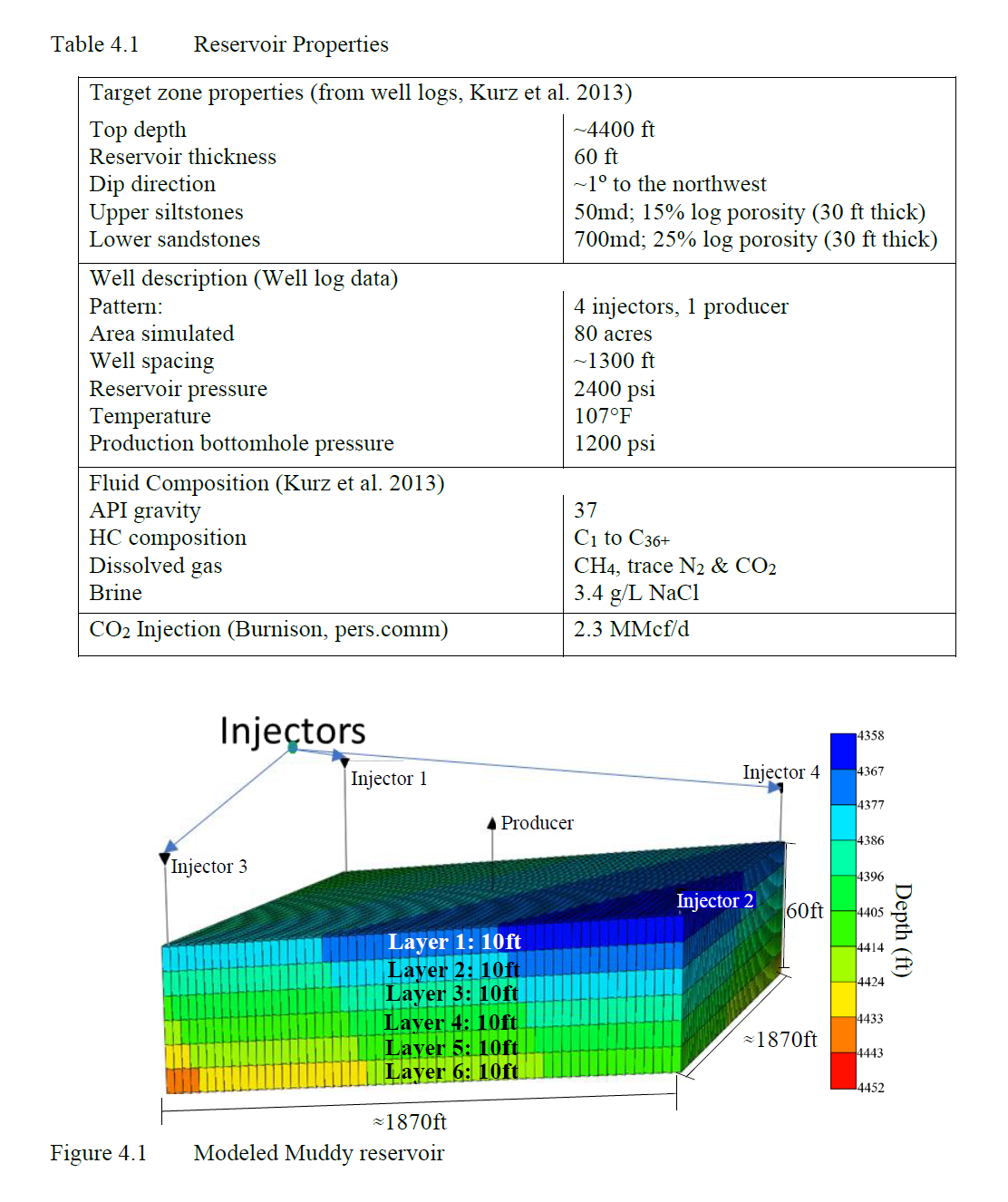RESERVOIR ANALYSIS OF A CO2 SEQUESTRATION SITE: EXPERIMENT-GUIDED FIELD SCALE MODELING
CCS过程需要引导物质运移并对地质层进行安全评估,以确保注入的CO2能够永久保留。尽管利用4D地震数据得出的CO2饱和度图可用于监测CO2注入期间的流体饱和度和压力响应,但它们并不能提供关于CO2与原有储层流体组分之间相互作用的详细机理,这些相互作用将影响矿场过程。因此,由于对空间和时间流体的认识不足,从4D地震数据得出的饱和度估计容易出现错误。
本研究提供了一种综合工作流程,用于解释连续封存到枯竭的油田中的地震图像,使用由实验和录井数据引导的储层模拟。利用CMG-GEM®储层模拟器,结合流动模型对地层内发生的地球物理效应进行解释,以获取洞察力。研究表明,油田中的注入井和生产井对CO2注入的响应不同。结果还显示,对油组分流动性的研究可以更好地解释4D地震图像,而不是典型的流体饱和度模型。仅仅使用储层模拟饱和度图并不能解释地下过程。通过将来自储层模拟的不同油组分流动性变化的影响添加到模拟4D地震响应中,我们能够更好地模拟地下过程。
ABSTRACT
Geosequestration is the storage of CO2 in geologic formations. This process requires guided transport to and safety assessment of geologic formations to ensure permanent retention of the injected CO2. Although CO2 saturation maps derived from 4D seismic data have been used to monitor fluid saturation and pressure effects during CO2 injection, they provide no detail of the interactions between CO2 and the components of prior reservoir fluid which influence field processes. Thus, saturation estimates from 4D seismic data are prone to errors based on a lack of knowledge about spatial and temporal fluid coverage.
This research provides a composite workflow to interpret a seismic map from ongoing sequestration into a depleted oil field, using reservoir simulation guided by experimental and well log data. The CMG-GEM® reservoir simulation results are interpreted with a flow model to provide insights on the geophysical effects occurring within the formation.
This study shows that injection and producing wells in oil reservoirs respond differently to CO2 injection. It also shows that the mobility of oil components can better explain 4D seismic maps than typical fluid saturation models. Using the reservoir simulation saturation maps alone does not explain subsurface processes. Adding effects of changing fluid mobility of the different oil components from reservoir simulations allows us to better simulate 4D seismic response.




This study has shown the influence of the fluid type around wells on neutron porosity measurements detected by NPHI logs. The changes in time-lapse NPHI log data from different wells varied based on the CO2 saturation around the wells. Time-lapse well log analysis shows that after CO2 injection, injection wells with the highest CO2 saturation and least oil saturation showed greater NPHI changes. Also, the NPHI changes around the producer, which had higher oil saturation and low CO2 saturation, showed insignificant NPHI time-lapse changes. These observations implied that the NPHI tool detects lower hydrogen index (HI) in wells surrounded by non-hydrogen-bearing CO2 and higher HI when a hydrogen-bearing fluid (oil or water) surrounds wells.
The reservoir simulation results from this research also show that during CO2 injection, there is a preferential displacement of lighter components of reservoir oil before the heavier components. This preferential displacement was found to be independent of the permeability and porosity variations within the reservoir. While the displacement of the reservoir hydrocarbons segregates, it was observed that the fraction of CO2 dissolved in oil within a cell and the fraction of C6 it contains are proportional. The competing effects of CO2 dissolution and the preferential hydrocarbon displacement are seen on oil viscosity because with more injection, there is CO2 dissolution in oil, lowering oil viscosity until a greater CO2 saturation is attained in which the CO2 dissolution ceases. The undissolved CO2 then displaces the C6 fraction and increases oil viscosity.
Also, the simulation results show that time-lapse changes in fluid properties (saturation, density, viscosity, and oil composition) at the injectors differ from those at the diagonal area and at the producer. Therefore, field measurements made in a well during CO2 injection monitoring may not represent the changes in the whole formation. Moreover, oil density decreases at the injectors while increasing at the producer and the diagonal area. The increasing oil density at the diagonal area was directly related to the simulated C36+ concentration that showed an accumulation of the heavy oil component in the diagonal area.
From the simulated seismic model, it was observed that continuous CO2 injection led to decreasing bulk modulus and seismic impedance. As the traditional method of Gassmann fluid substitution was compared with the Gassmann model incorporating fluid segregation, it was observed that a failure to account for fluid segregation in Gassmann forward models might predict a larger seismic sensitivity than would be measured. Conversely, simplifying fluid effects to only saturation in the Gassmann model would lead to a drastic underprediction of CO2 saturation.
While comparing the change in fluid density and fluid bulk modulus, it is observed that the former had less than 10% change while the latter had about 70% change. This difference in sensitivity to the CO2-oil effect shows the relevance of using multiple data sources (field, laboratory, and models) in analyzing changes in EOR and sequestration fields. Furthermore, the limitations in each analyzing technique emphasize the need for other methods in understanding reservoir events in detail.
Finally, the changing seismic properties due to fluid effects noticed during the study provide a compelling reason for which changes in fluid properties and fluid composition should be considered during the seismic modeling of CO2-EOR or sequestration processes because field changes are not only explained by saturation.
